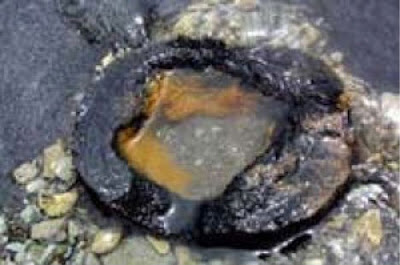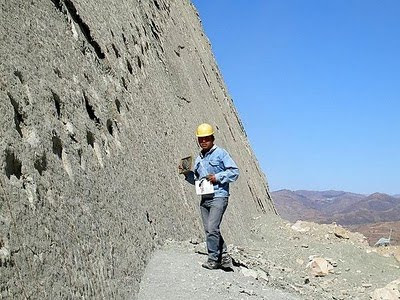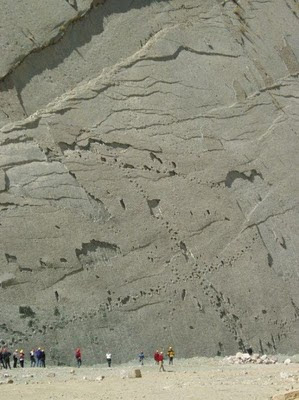I remember a scene in the TV series Jericho where the mysterious character Hawkins says “the prospect of torture is a much more effective means of interrogating people” or something along those lines. Too bad hundreds of thousands of sadists over the centuries didn’t know that, and proceeded to inflict on their millions of victims the worst pain imaginable, which, more often than not, resulted in a very painful death. Here are some of the twisted devices they used to do just that:
The “Boots”

If you think the Knee Splitter was murder on a person’s lower limbs, wait til you know what the “Boots” were about. This horrible piece of equipment was made up of wedges that fitted the legs from ankles to knees. Pure pain ensues when the torturer violently pounds the wedges with a large, heavy hammer, a process that is done repeatedly until flesh and bone are completely destroyed, with some victims even gushing marrow from their crushed legs.
Brazen Bull

“The brazen bull is an execution/torture device designed in ancient Greece. Perillos of Athens, a brass-founder proposed to Phalaris, Tyrant of Agrigentum, the invention of a new means for executing criminals; accordingly, he cast a brazen bull, made totally of brass, hollow, with a door in the side. The condemned was shut up in the bull and a fire was set under it, heating the metal until it became “red hot” and causing the person inside to slowly roast to death. So that ‘nothing unseemly might spoil his feasting’, Phalaris commanded that the bull be designed in such a way that its smoke rose in spicy clouds of incense. The head of the ox was designed with a complex system of tubes and stops so that the prisoner’s screams were converted into sounds like the bellowing of an infuriated bull. ”
No way those who were roasted alive in this device looked anything like the serene faces in the above picture.
Breast Ripper
This one is self-explanatory. Many women condemned as heretics, adulterers, blasphemers had their breasts ripped out using this device.
Head Crusher

Here’s another torture device with a self-explanatory name. The chin of the victim is placed on the lower bar, When the questioning starts, the screw starts to turn and the cap is forced down the victim’s head. Use your imagination to see what happens when that cap is pressed all the way down a person’s head.
The amazing part is, the Head Crusher is said to be still in use up to this day for interrogation purposes.
Heretic’s fork
One end of this device was pushed under the chin, the other into the sternum, with the strap securing this torture tool to the victim’s neck. Immobilized and in great pain, the victim will have to mouth off the Latin word “abiuro” (I recant), or they’ll end up being hanged or worse, burned at the stake.
Inquisitional Chair
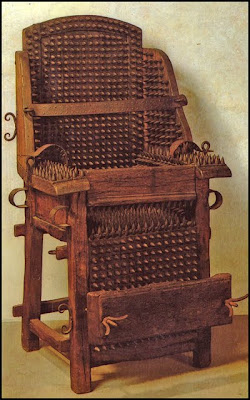
An Indian fakir would absolutely love this chair, but not those victims of the Inquisition who were unfortunate enough to sit on it butt naked. Strapped tight to it with leather straps, those who sat on this chair felt the pain of hundreds of sharp and rusty spikes piercing their flesh, and that pain is magnified even more when torturers decide to press them down against the spikes. For added fun, torturers heated this iron chair and effectively roasted slowly the poor unfortunate souls sitting on it.
Iron Maiden
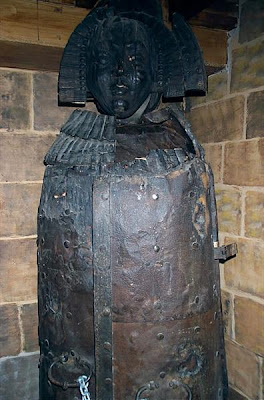
Not the 80s heavy metal band, but the iron cabinet found in Nuremberg, Germany. The interior of this device is lined with strategically-placed sharp objects that is intended to torture a person unlucky enough to be put inside it. These spikes impaled the victim in the eyes, the chest and the back, but usually missed vital organs, so as to leave the victim bleeding profusely and in great pain, but still alive for a period of time.
Crocodile shears
Had this device been still in use in the 20th century, people like Lee Harvey Oswald or John Hinckley, Jr. might have thought twice before doing the deeds they are infamous for. You see, captured assassins of kings in late medieval Europe often had a date with this device, which is actually an iron pincer with hemicylindrical blades that formed a long narrow tube when closed together. Teeth or spikes lined the inside of the blades, which are first heated until red-hot before being clamped on the victim’s penis. When his sex organ is “cooked” enough, it is then torn out from his body. Ouch.
Judas Chair
The Spanish Inquisition was said to have made use of, among other things, the Judas Chair, also known as the Judas Cradle. Victims were hoisted up by rope or chain and then made to sit on the pointed tip of the pyramid shaped device. You get the picture.
Knee Splitter

A popular torture device during the Inquisition, the knee splitter does what it says: split victims’ knees and render them useless. Built from two spiked wood blocks, the knee splitter is placed on top of and behind the knee of its victims. Two large screws connecting the blocks are then turned, causing the two blocks to close towards each other and effectively destroy a victim’s knee.
Lead sprinkler

This tool, which kinda reminds me of a holy water sprinkler, was filled with either molten lead, tar, boiling oil or boiling water, then used to bless, errr, torture its victims by dripping its contents on their stomach, back and other body parts. Sounds like standard S&M practice to me, only with a greater deal of pain.
The Pear

Commit sodomy, adultery, incest, heresy, blasphemy or sexual union with Satan (!) in Medieval Europe, and chances are, you’ll get this intricately-decorated device inserted into your mouth, rectum or vagina. A screw mechanism then makes its pointed “leaves” expand while inside any of those orifices, resulting in severe internal mutilation. Yikes.
Rat Torture

This method tortures both man and rodent, but it is man who tends to end up dying a horrifying death. A victim is completely restrained, and a full-grown rat is placed upon his or her stomach. The rat will be confined within a cage placed on top of it, which would then be heated, freaking the rat out enough to frantically burrow its way into the only way out: the victim’s stomach and intestines.
Revolving Drum
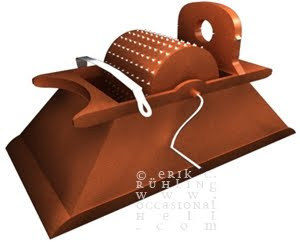
Think of this one as somewhat akin to grating cheese, only this one grates a human torso ever so slowly. A popular tool in Spain for extracting information from prisoners many years ago, the Revolving Drum calls for victims to be put into it face down, their heads through the upper pillory and their legs firmly strapped. Their torsos pressed against a spiked drum, the prisoners are then asked questions. Any sign of resistance, and the torturer then slowly rotates the drum one full revolution. This process is repeated, and torturers even go to the extent of placing weights on the backs of victims to further press their torsos towards the spiked drum and cause more pain. The result, naturally, is death by very slow disembowelment.
The Saw

Who would have thought that one of the most useful tools ever invented by man could also become one of the sickest? The saw, which has helped mankind slice through trees en route to building houses and shopping malls, also has a dark past as a torture / execution device. And the way it was used would make the strongest of stomachs churn out its lunch.
Victims of this indescribably brutal device were made to hang upside down, legs spread apart. Even this position has a purpose: to fill the victims’ heads with blood, and therefore allow them to remain conscious as the torturers work the saw through their crotches, sometimes up to their midsection before they pass out or die. Just imagine the sound the whole process would have made, with the saw’s serrated edge making contact with flesh and bone with each back and forth motion, on top of the victim’s bloodcurdling screams of agony.
The Skull Splitter

Just as it says: it splits skulls. This one resembles an angel’s halo, but there’s absolutely nothing angelic or holy about it. Inside this halo are very pointy spikes, which are driven into the side of the victim’s skull as the screws on the outside are tightened. The skull splitting part comes when the torturer either grabs the halo by its handles and jerks the victim side to side or hoists him or her into the air, by those very same handles. It doesn’t take a genius to figure out that the top of the victim’s skull is violently removed by the aforementioned actions, and that brains tend to spill out all over the place in the process.
Spanish Donkey
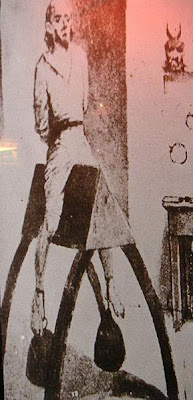
A number of medieval torture devices have the word “Spanish” attached to it, but this one is probably the most gruesome. The Spanish Donkey gave victims an unimaginably horrible ride, and here’s why. Victims are put astride, naked, the apparatus, which is actually a vertical wood board with a sharp V-shape wedge on top. Varying weights are then attached to their feet. Eventually, the victim’s own weight and the extra baggage cause the wedge to slice through their bodies, splitting them in half. Yikes.
The Spanish Tickler
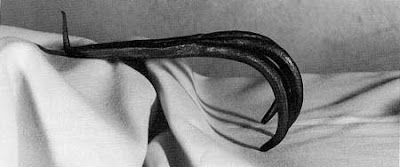
The Spanish Tickler tickled its victims pink, and ultimately very red as this device, also known as the Cat’s Paw, ripped and tore their flesh away from the bone, targeting any part of the body.
The Rack
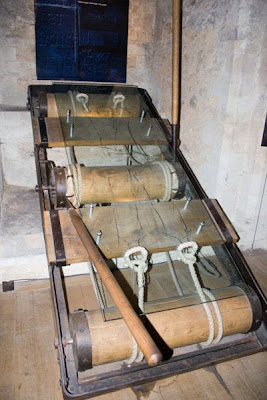
The rack is a contraption designed to dislocate every single joint in its victim’s body. Tied across the device’s board by the ankles and wrists, the victim’s body is then pulled in opposite directions by turning rollers at either end of the board. Great way of relieving a bad back, if you ask me. Of course, the subsequent pain caused by the multiple dislocations is another story.
The Wheel

This device is known by many names, such as breaking wheel and Catherine wheel, but it only means one thing to those who perished by this means: pure agony.
The Wheel is more like an execution device, but the hours before actual death is excruciating. The victim is tied to the side of the wheel, then gets every bone in his body shattered one by one by an executioner using a hammer or an iron bar. Victims of this form of torture often took hours, or even days to die. Some were “fortunate” enough to be granted “mercy”, in the form of fatal blows to the chest or stomach.
Thumbscrew
There are many variations on this torture device. Some were designed to slowly crush fingers, while others were built to do the same to toes, knees and elbows. Just a simple vise, really, but extremely painful.
Tongue Tearer

Countless heretics and blasphemers had their tongues roughly torn out with this simple device. My, weren’t they the popular ones during those times.
Source




